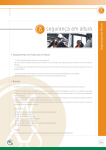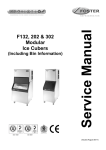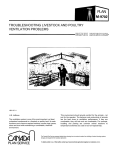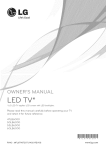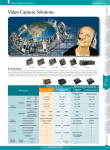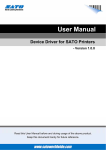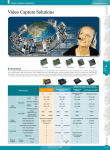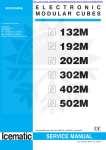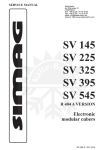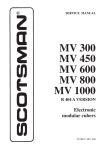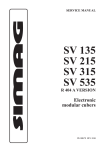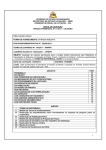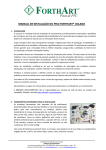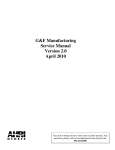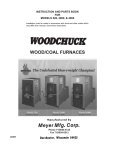Download FMIC/F200/F300 Ice Cuber-A3
Transcript
Tel: 01553 691122 Fax: 01553 691447 Website: www.fosterrefrigerator.co.uk E-mail: [email protected] a Division of ITW (UK) Ltd. F/FMIC/SM/03/03 By Appointment to Her Majesty Queen Elizabeth II Suppliers of Commercial Refrigeration Foster Refrigerator (UK) Ltd King’s Lynn Service Manual Service Manual Foster Refrigerator Oldmedow Road, King’s Lynn, Norfolk PE30 4JU England F200 & F300 Modular Ice Cuber & FMIC 180 & 260 Electronic Modular Ice Cuber F200 & F300 Modular Ice Cuber CONTENTS - F200 & F300 1. Page 4 4 4 4 SPECIFICATION 1.1 Capacities 1.2 Installation Notes 1.3 Stacking Installation INSTALLATION INSTRUCTIONS 5 2. START UP CYCLE 2.1 Start Up Cycle 2.2 Freezing Cycle 6 6 6 3. HARVEST CYCLE 6-7 4. OPERATION 4.1 Refrigeration During Freezing 4.2 Water System During Freezing 4.3 Ice Harvest Cycle 4.4 Water System During Ice Harvest Cycle 4.5 Control Sequence 7 7 7 7 7 7-8 5. ALARM CONDITIONS 8 6. P.C. BOARD SET UP 6.1 Water Error 6.2 Too High Condensing Temperature 8 8 8 7. COMPONENT DESCRIPTION 7.1 Front Console Panel 7.2 P.C. Board 7.3 Compressor Contactor 7.4 Ice Thickness Sensor 7.5 Magnetic Switch 7.6 Hot Gas Valve 7.7 Condenser Temperature Sensor 7.8 High Pressure Control 7.9 Water Regulating Valve (water cooled models only) 7.10 Water Distribution System 7.11 Water Drain Solenoid Valve 7.12 Thermostatic Expansion Valve 7.13 Water Pump 7.14 Water Inlet Solenoid Valve (male fitting) 7.15 Water Level Sensor 8. WIRING DIAGRAM 10 9. SERVICES DIAGNOSTICS 11 10. MAINTENANCE, CLEANING AND SANITATION 10.1 Icemaker 10.2 Ice Storage Bin 10.3 Cabinet Exterior 10.4 Cleaning Ice Maker 12 12 12 12 12 2 9 9 9 9 9 9 9 9 9 9-10 10 10 10 10 10 10 FMIC 180 & 260 Electronic Modular Ice Cuber CONTENTS - FMIC 180 & 260 Page 1. SPECIFICATIONS 13 2. FOR THE INSTALLER 2.1 Important operating requirements 2.2 Select location 2.3 Ice machine 2.4 Final check list 14 14 14 14 14 3. FOR THE PLUMBER 3.1 Conform to all applicable codes 3.2 Water Inlet 3.3 Drains 15 15 15 15 4. FOR THE ELECTRICIAN 4.1 Electricial Connections 15 15 5. START-UP 5.1 Start-up 15 15-16 6. OPERATION 6.1 Refrigeration during freeze 6.2 Water system 6.3 Refrigeration system during harvest 6.4 Water system 6.5 Control sequence 16 16-17 17 17 17 17-18 7. SERVICE SPECIFICATIONS 7.1 Component 7.2 Operating characteristics 7.3 Freeze cycle 7.4 Harvest cycle 18 18 18 18 18 8. COMPONENT DESCRIPTION 18-19 9. REMOVAL AND REPLACEMENT PROCEDURES 20-21 WIRING DIAGRAMS - FMIC 180 & FMIC 260 22 10. SERVICE DIAGNOSIS 23 11. MAINTENANCE AND CLEANING INSTRUCTIONS 11.1 Ice maker 11.2 Ice storage bin 11.3 Cabinet exterior 11.4 Cleaning (Ice maker) 23 23-24 24 24 24 12. ASSEMBLY INSTRUCTIONS OF CONVEYOR KITS FOR ICE MACHINES TO BE FITTED ON STORAGE BIN 24-25 13. WIRING DIAGRAM CONCERNING THE CONNECTION OF UPPER ICE MAKER MICRO TO CONVEYOR KIT MICRO 25 14. GUIDELINES FOR ICEMAKER BIN LIDS 25 3 F200 & F300 Modular Ice Cuber 1. Specification 1.1 Capacities Output (kg/ 24 hours) Bin Storage Capacity (kgs) Cubes Per Cycle (kgs) Standard Cube Size Cycle Time (minutes) Amps start/run Watts Consumption Machine Weight net / gross (kgs) Refrigerant Refrigerant Charge Discharge Pressure Freeze Cycle High Pressure Cut Out High Pressure Safety Switch Suction Pressure Freeze Cycle Compressor Amps Freeze Mode Voltage Reservoir Water Level Water inlet Connection 1.2 F200 F300 215 150/ 210 2.3 24mm x 24mm x 26mm 16 29/5.5 1000 70/85 R404A 500 grms Max 17 bar/ Min 15 bar 30 bar Cut in 20 bar/ Cut Out 33 bar Start 3.6 bar/ End 2.3 bar Start 4.2 amps/ End 3.4 amps 230/50/1 40mm to 45mm 3 /4 gas 320 150/210 2.3 24mm x 24mm x 26mm 11 31/8.5 1600 73/88 R404A 850 grms Max 18 bar/ Min 16 bar 30bar Cut in 20 bar/ Cut Out 33 bar Start 3.6 bar/ 2.5 bar Start 7.0 amps/ End 5.2 amps 230/50/1 40mm to 45mm 3 /4 gas Fig.4 13. Fig.5 Fig.6 Wiring Diagram Concerning The Connection Of Upper Ice Maker Micro To Conveyor Kit Micro 1. Detach the light blue (No.13) cable of the upper ice maker; this cable is connected to the NC contact (usually closed) of the micro. Connect it to the light blue (No.14) cable which is joined to the NO contact (usually opened) of the conveyor kit micro. 2. Connect the brown (No.16) cable which comes from the COM (common) contact of the conveyor kit micro to the NC contact (usually closed) of the upper ice maker micro. Installation Notes. Allow 15cm minimum space at the sides and back for ventilation. Bin Installation The F200 and 300 fit the New SB150 Bin. The F200 and F300 can be fitted to the New SB210 Bin but a KN311 Lid is required. The F200 and F300 can be fitted to the Old SB150 Bin but a SB150 frame is required, as the F200 and F300 are smaller than the Old SB150 Bin. The F200 and the F300 can be fitted to the Old SB210 Bin provided the KN310 lid is fitted first. However it is necessary to re-drill the lid to secure the machine to it. 1.3 Stacking Installation. To stack a Modular Cuber onto the present one, first remove the top panel from the lower machine. Add a bead of food grade silicone sealer to the top edges of the lower units freezing compartment. Lift the top machine onto the bottom machine, (the use of a mechanical lift is recommended). Align the two machines, and using the two screws supplied in the hardware package supplied with the top machine, fasten the two together through the fixing holes on either side of the machines. Fit the Stacking Kit KS into the bottom machine as per the instructions supplied with the kit. Using food grade silicone sealer, seal the edges between the freezing compartments of the top and bottom machine so as to avoid any possible leakage of water through the join. 14. Guidelines for Icemaker Bin Lids SB 150 BIN NO BIN LID SB 210 BIN KN 310 BIN LID SB 150 BIN NO BIN LID SB 210 BIN KN 310 BIN LID SB 150 BIN NKF 200 BIN LID SB 210 BIN NKF 310 BIN LID SB 210 BIN NKF 310 BIN LID FMIC 180 HEAD FMIC 260 HEAD FMIF 220 HEAD FMIF 550 HEAD 4 25 5. Check and tighten all bolts and screws. 6. Check for water leaks and make corrections. 7. Check the bin control to test shut-off. Holding the evaporator deflector in open Position for more that 30secs, should cause the ice maker to shut-off at the end of harvest cycle. Once the evaporator deflector is released in its closed position, the ice maker will restart. 8. Check cube size, adjust if required through setting screw of ice thickness control sensor. 9. With unit out of operation, clean the condenser using vacuum, cleaner, whisk broom or brush. Instruct customer to clean condenser frequently DO NOT USE A WIRE BRUSH. 11.2 Ice Storage Bin The interior liner of the bin is in contact with a food product, ice, and should be cleaned regularly. Once a week clean with soap and water, and after that a hot water rinse and dry thoroughly. Commercial food grade sanitisers are available, and may be used. 11.3 Cabinet Exterior Wipe clean unit and bin cabinet exterior with a clean cloth or disposable paper wipers, soaked in warm water with mild detergent solution. 11.4 Cleaning - Ice Maker WARNING - Ice Machine Cleaner contains Phosphoric and Hydroxyacetic acids. These compounds are corrosive and may cause burns. If swallowed, DO NOT induce vomiting. Give large amounts of water or milk. Call physician immediately. In case of external contact, flush with water. KEEP OUT OF THE REACH OF CHILDREN. 1. 2. 3. 4. 5. 6. 7. 8. 9. 10. 11. Empty bin of ice. Remove front panel. Switch the Master switch power line and Unit Toggle switch OFF Remove evaporator cover deflectors by lifting-up and pulling-up. Switch the Master switch power line ON. Pour 200grs of Ice Machine Cleaner into the reservoir and put the unit toggle switch to WASH position. Run unit for 15 minutes. Using correct brush clean the interior of each evaporator egg-crate using the cleaning solution from the water reservoir. Switch to OFF, remove the drain plug from the water reservoir to flush cleaning solution out of the reservoir. Replace the plug and allow fresh water through float valve to fill-up the reservoir to thoroughly rinse it. Repeat the reservoir flushing out two or three times. Switch the toggle switch to ICE position. Replace the evaporator cover deflector and front panel. Check the next batch of cubes to be sure all the cleaner has gone (no sour taste). CAUTION: DO NOT use ice cubes produced from the cleaning solution. Be sure none remains in the bin. Installation Instructions Before bringing the icemaker into action perform the following operations: preface Warning! It is expressly forbidden for the users of the equipment to carry out the following operation or those marked by the symbol, Such operations must be performed exclusively by qualified personnel. 1. Electrical connections 2. Water mains connections 3. Machine installation 4. Machine test run 5. Repairing machine components and parts 6. Disassembly of machine and/or components 7. Adjustment and setting procedures 8. Machine cleaning and maintenance relative to the following parts and components: Electrical, Electronic, Mechanical, Cooling System general specifications Models 200 KG, 300 KG, The icemaking machines are approved by VDE, GS and the relative symbols are put on the packing, serial plate and body of the machine (Fig.10). Fig 10. 12. Pour hot water into the storage bin to melt the cubes, and to also clean the bin drain. 12. Assembly Instructions of Conveyor Kits for Ice Machines to be fitted on Storage Bin 1. Fit the cover kit on the storage bin of 300kg (as indicated in Fig. 1) and put the lower ice maker on the bin as indicated in the instruction manual. 2. Remove the cover and the 4 bushes (No.3) of the lower ice maker (Fig. 2), then apply the support gaskets No.4. 3. Remove the front and the 2 lateral panels of the lower ice maker and fit the conveyor support No.5 (Fig. 3). 4. Fit the conveyor kit (No.7 - Fig. 4). 5. Apply the upper ice maker after having removed the front and the 2 lateral panels and fix it to the lower ice maker through 2 screws on the lateral edges. 6. Hook the shoot conveyor (No.10 - Fig. 6) at the edge of the upper ice maker water pan and fix it to the vertical conveyor No.7, previously fitted on the lower ice maker (as indicated on Fig. 6). 7. Connect the upper ice maker micro to the conveyor kit as explained on Fig. 5 and on the enclosed wiring diagram. 8. Place back the panels previously removed. OUR PRODUCTS ARE GOVERNED BY EC LOW VOLTAGE DIRECTIVE 73/23/EEC EMC - 89/336/EEC AND THE COVER OF THE MANUAL IS MARKED ACCORDINGLY. Fig.3 Fig 20. 3) Clean the inside of machine and storage bin by means of a warm water and sodium-bicarbonate dampened sponge; rinse with plain water and dry thoroughly. 4) Locate the icemaker and the storage bin in the final place, making sure that the two are perfectly level, in order to obtain an even distribution of the water all over the evaporator and a uniform filling of the cube plate (Fig.13). The storage bin is equipped with adjustable feet, which allow for easy levelling and sufficient height for cleaning under the machine. 1 Note Before installing the machine make sure that: a) the room temperature must not fall below 10˚c (50˚F) or above (100˚F). b) the water conductivity value must not be below 10 µs/cm. c) the main water temperature must not fall below 5˚C (40˚F) or above 35˚C (95˚ F). Fig 11. Fig.2 Fig 1. 2) Match the icemaker to its storage bin, fixing them with the two screws supplied with the machine (Fig.20). installation d) the main water pressure must not fall below 1bar. (14 PSI) or above 5 bar. (70 PSI). If pressure is above 5 bar. a pressure regulator should be fitted to the water supply to the machine (Fig.11) Fig.1 1) Check that ice cuber has not been damaged during transportation (Fig.1) e) machine is away from sources of heat and in a sufficiently ventilated area. A distance of at least 20cm must be allowed between the sides, back and the walls of the machines (Fig.12, Fig.14). f) the machine will not work with demineralized water. 11) Fit the flexible drain pipes to the icemaker and the storage bin ensuring there is adequate fall on the pipes to avoid the drain water backing up. For a perfect water outlet from the machine a minimum incline of 3% of the pipes is advisable. Check also that the pipes are not throttled or siphoned. It is advisable that the pipes discharge in an open vented drain (Fig.18). 12) Connect the machine to the electricity supply after having Fig 13. checked that the voltage corresponds to that on the plate on the rear panel of Fig 5. the machine (Fig.5). The maximum voltage variation should not exceed ± 6% of that stated on the rating plate. A fused isolator must be included in the electrical circuit to the machine, with its own bipolar main switch at least 3 mm. of contacts opening. The machine should be connected to a suitable power supply with earth terminal. Fig 17. Fig 16. 5) Unlock the sensor and the baffle by removing the transit packaging 1and tape 2, which have been applied to avoid any damage during transportation (Fig.16 & Fig.17). 6) The icemaker has been designed for coupling with another icemaker, which can be installed on the top of the first one. For this installation, a kit can be supplied upon request. It contains all necessary assembling instructions. Fig 24. 7) Do not put the machine in a dusty environment as this could cause a fast build up of dust etc, therefore effecting the efficient working of the condenser (only for air-cooled models). 8) Never keep food, bottles or other things in the bin in order to avoid the stored ice becoming tainted. 9) Connect machine to the water supply first and then to a suitable electricity supply. Fig 12. Fig 14. 2 24 10) Connect the 3/4" Feeding pipe (supplied) to the machine and to the cold drinking water supply line. It is advisable to install a shut-off valve (not supplied) to the water feed pipe. If the feed water contains impurities, the installation of a filter system is recommended. If the Fig 18. water is particularly hard, i.e. rich in minerals and their derivatives, the application of a suitable water filter is recommended, preventing any scale deposits blocking the water circuit of the machine (Fig.18). 5 13) Air deflector installation. (Fig.24) The deflector has to be installed in order to prevent the re-circulation of hot air to the condenser. 2. 2.1 Start Up. 10. The table below is intended as a quick reference to aid the Service Agent to determine the cause of a particular type of malfunction, as well as the recommended repair. It is not intended to be an exclusive list. Reference to other portions of this manual including wiring diagrams, installation, and operation are recommended to better determine the cause of a problem. Start–up Cycle. Open the water valve and switch on the power to the machine. The machine enters the Start-Up mode with the energising of the PC Board with the green LED (Power On) illuminated. It is necessary to remove the front cover of the machine to see all of the LED’s. The Green LED of Machine In Operation is also energised, blinking fast for 40 seconds prior to the start up of the machine. Power On.‘Green’. Bin Full/ Washing. ‘Amber’. Machine in Operation ‘Green’. Alarm ‘Red’. High Pressure. ‘Red’. Symptom Possible cause Correction Machine does not run at all. Master switch open. Hi-pressure safety switch open W.C. E.C. board inoperative. No power to unit. Test and replace. Test and replace. Remove board and check. Check electrical source. Machine does not run. Bin full of ice N.C. contacts of control switch open. Magnetic switch inoperative. Interface P.C. Board inoperative. None Check and replace. Check and replace. Check and replace. Machine does not run. The harvest cycle time is too long causing safety device to trip-off unit Press the ‘reset’ push button to resume operation and check freezing and harvest time. Machine runs, compressor does not. Toggle switch open in ICE position. Compressor contactor open. Compressor relay open. Compressor winding open. Test and replace. Test and replace. Test and replace. Test and replace. Machine runs, makes no ice. No water in reservoir Water, but not pumping. Water pumping but does not cool. Check water supply and float valve. Check power to pump, replace pump. Check refrigeration system pressure, check system for leak, check condenser condenser for clog, or poor air circulation, check compressor. Test and replace relay, must be energised to freeze. Machine runs, makes ice, does not try to harvest Ice thickness control open Check sensor fingers are not covered with scale sediment. Check and replace P.C. Board. Reset / Washing. ‘Push Button’. During the start up cycle the following components in operation are. Hot Gas Valve. Water drain valve. Water pump. • • • 2.2 Service Diagnosis Freezing Cycle. After the Start Up cycle the machine enters directly into the Freezing cycle with the following components in operation: Water Inlet Valve Compressor Fan Motor (running continuous for the first three minutes). The LED’s energised are: Machine Power On. Machine in Operation (constant). Water is coming into the water reservoir through the Water Inlet Solenoid Valve until it reaches the maximum level controlled by the Water Level Sensor. After 30 seconds the Water Pump starts up. 3 minutes after the start of the freeze cycle the Water Inlet Solenoid Valve is activated for a few seconds until the water reaches the maximum level, this is to reduce the possibility of slush ice formation. In the meantime the condenser sensor starts to transmit the current to the PC Board keeping in operation the Fan Motor in ON-OFF mode or continuously according to the condenser temperature. • • • • • Note: Do not remove the evaporator deflector, as it will cause the switching off of the machine at ‘FULL STORAGE BIN’. The machine remains in the freezing cycle with the ice becoming thicker until the two metal fingers of the Ice Thickness Sensor (energised at low voltage) are covered by the water cascading over the front surface of the ice plate. If the contact between the two metal fingers remains established (by the water) for more than 10 seconds power is transmitted back to the PC Board and the machine enters into the Harvest Cycle mode depending on: Fan motor in ON-OFF Mode during the previous freezing cycle. If the Condenser Sensor detects a rise in temperature to 38°C (due to high Ambient) the length of the freezing cycle is extended by 30 seconds before entering the harvest mode. Fan motor running CONTINUOUSLY during the previous freezing cycle. Goes straight into the harvest mode. The first freezing time will range between 15 and 20 minutes. Freeze time will be longer if the ambient temperature is above 25°C and shorter if it is below 25°C. The Average cycle time is about 22 minutes. Built-in transformer for ice thickness control open. Built-in relay on P.C. Board open. Check and replace P.C. Board. Machine runs, makes and harvests ice, but very slowly. Low refrigerant charge. Check system, repair leak weigh in charge. Low ice capacity. High discharge pressure due to notcondensable or overcharge. Inefficient compressor. Condenser dirty. Low water pressure (water-cooled). High air temperature (air cooled) Evacuate and weigh in charge. Low water supply. Water pump not running. Plugged water distributor. TXV super heat wrong. Refrigerant charge low. Check float valve not maintaining proper water level in reservoir. Check and repair or replace. Clean machine. Adjust or replace. Adjust - check or leak. Recharge. Hot gas valve coil open. Hot gas valve will not open. Test and replace hot gas valve. Test and replace hot gas valve. • • 3. Harvest Cycle Machine makes irregular ice. Machine runs, makes ice, but does not harvest.. During the harvest cycle the components in operation are: Hot Gas Valve. Water Drain/Purge Valve. Water Pump for the first 40 seconds. Compressor. And both of: Power On LED. Machine In Operation LED. 30 seconds from the start of the harvest cycle, the Water Inlet Solenoid valve is energised for ten seconds to allow fresh water into the sump whilst the pump is in operation. The Fan Motor remains in OFF mode unless the condenser probe detects a rise in temperature above 38°C (Same as per the freezing cycle). When the Ice Plate falls down from the evaporator, the magnetic switch is activated sending a signal back to the PC Board to start a new freeze cycle. Check the cubes from the first harvest to determine if any adjustments are required: If any adjustments are needed either turn IN or OUT the screw shown as 1 in the illustration. The screw position (factory set at 6mm) determines the distance between the sensor fingers and the front of the evaporator therefore setting the ice cube thickness. • • • • • • NOTE: This type of machines produces an “Ice Plate” that breaks when it falls into the storage bin. Setting the ice thickness sensor to have single ice cubes may cause the machine to malfunction. 6 11. Replace. Clean. Check and repair. Check temperature of air entering condenser. Maintenance and Cleaning Instructions A FOSTER Ice System represent a sizable investment of time and money in any company’s business. In order to receive the best return for that investment, in MUST receive periodic maintenance. It is the USER’S RESPONSIBILITY, and less costly in the long run, to avoid possible down time by keeping it clean, adjusting it as needed and by replacing worn parts before they can cause failure. The following is a list of recommended maintenance that will help keep your machine running with a minimum of problems. Maintenance and Cleaning should be scheduled at a MINIMUM of twice per year. 11.1 Ice Maker THE FOLLOWING MAINTENANCE SHOULD BE SCHEDULED AT LEAST TWICE A YEAR ON THIS ICE MAKER. CALL YOUR AUTHORISED SERVICE AGENCY 1. Check and clean or service any optional water treatment devices, if any are installed. 2. Clean water strainer. 3. Check that the cabinet is level, in the side-to-side and front-to-back directions. 4. Clean the water system, evaporator plate and sump assembly, using a solution of Ice Machine Cleaner. Refer to CLEANING - Ice maker. NOTE: Cleaning requirements vary according to local water conditions and individual user operation. Continuous checking of the clarity of ice cubes and visual inspection of the water system parts, evaporator plates and the sump assembly before and after cleaning will indicate frequency and procedure to be followed in local areas. 23 Check the second and third cube harvest. Ensure that they are the correct size and make adjustments to the Ice Sensors Fingers as necessary. In certain areas where there are extreme water problems it may be necessary to fit a filter or purifying equipment. Wiring Diagrams NOTE. To ensure a correct operation of the machine the water must have a minimum electrical conductivity level of 20 us. Open the bottom end of the plastic ice deflector for 30 seconds to check the operation of the magnetic switch. The machine will switch OFF and the Amber LED will glow to indicate machine OFF at full storage bin. Releasing the deflector will restart the machine in the freezing mode commencing with the 3-minute delay. Replace all panels and screws previously removed. 4. Operation A B C D E F G – – – – – – – Power Terminal block Contactor Compressor Toggle switch Pressostat Ice sensor H – N.C. Microswitch / Magnetic Switch L – Electronic card M – Fan motor N – Motor pump O – Water drain valve P – Hot gas valve 180 + 260 Wiring Diagram Air Cooled 220 V. 50 Hz 1 ph Colour of the Cables m – Brown bc– Light blue gv– Yellow green b – White n – Black r – Red NOTE. If the water is too soft (demineralized) the Ice Thickness Sensor may not be able to sense the water on its fingers, thereby not switching the unit onto the harvest cycle. In the event of this occurring a safety system built into the PC Board will automatically switch the unit into the harvest mode if the freezing period goes beyond 30 or 40 minutes. 4.1 Refrigeration during freezing. This ice machine employs either air (standard) or water (optional) as a condensing media, the refrigeration system for either one is as follows: The refrigerant metering is by thermostatic expansion valve. 4.2 Water System during freezing. A combination of the water inlet solenoid valve and water level sensor is used to control the level of the water in the reservoir/sump. 30 seconds from the start of the freeze cycle the water pump starts, forcing water to the top of the evaporator where it is distributed through the water tube and then cascades over the surface of the evaporator by gravity. Some of the water will turn to ice with the remainder returning to the water reservoir for redistribution over the evaporator. 4.3 Ice harvest cycle. When the ice reaches the desired size, as determined by the fingers of the ice thickness sensor, the hot gas bypass valve is energised allowing the hot gas to warm the evaporator resulting in the ice cube block falling into the storage bin below. 4.4 Water system during ice harvest cycle. During the harvest cycle, the electric water drain valve is energised opening the drain line. All of the water remaining in the reservoir at the end of the freezing cycle is pumped, out to drain, through the water solenoid valve during the last 40 seconds of the defrost cycle eliminating any possible build-up and accumulation of mineral concentration and other impurities in the reservoir. The water inlet valve is energised for the last 10 seconds whilst the pump is running to allow fresh water to rinse the reservoir. When the ice cube block is released from the evaporator it causes the deflector to swing open sufficiently to reset the contactor of the magnetic switch which, via the PC Board, de-energises the water drain valve initiating a new freezing cycle. The harvest/defrost cycle lasts between 1 and 2 minutes. 4.5 Control sequence. At the start of the freezing cycle the contacts of the magnetic switch, mechanically operated by deflector cover, are closed via the PC Board, thereby closing the circuit to the main contactor coil and consequently the compressor, fan motor and after 30 seconds the water pump. As the ice reaches the thickness required the film of water flowing over it makes contact with the ice thickness sensor fingers (energised at low voltage). If contact is maintained for more than 10 seconds a relay on the PC Board is energised controlling simultaneously the hot gas valve and the water drain valve. A B C D E F G – – – – – – – Power Terminal block Contactor Compressor Toggle switch Pressostat Ice sensor H – N.C. Microswitch / Magnetic Switch L – Electronic card M – Fan motor N – Motor pump O – Water drain valve P – Hot gas valve 180 + 260 Wiring Diagram Water Cooled 220 V. 50 Hz 1 ph Colour of the Cables m – Brown bc– Light blue gv– Yellow green b – White n – Black r – Red REFRIGERATION SYSTEM SCHEMATIC NOTE: In the event of failure of the ice thickness sensor, the PC Board automatically turns the unit into the defrost cycle when the freezing cycle reaches 30 or 40 minutes depending on the operation of the fan motor during the freezing cycle. At this point the unit initiates the defrost cycle. The hot gas circulating into the evaporator serpentine causes a slight melting of the ice cube 22 7 block releasing it from the mould. Once released the ice block drops into the storage bin below and breaks into individual cubes, in the process it moves the deflector plate forwards. The defector has on its side a magnetic switch that when it moves forward it opens and closes the contacts. This motion deactivates the relay contacts that control the hot gas and water drain valve allowing the unit to start a new freezing cycle. When the ice bin is full of ice, the last batch of ice released from the evaporator cannot continue into the bin and so it stops the deflector from returning to its position. With the magnetic switch contacts remaining open for more than 30 seconds the entire unit stops with the glowing of the Amber bin full LED. The machine will restart when the deflector returns to its normal position provided the machine has been of for more than 3 minutes, if not the start will be delayed for 3 minutes with the blinking of the green Machine In Operation LED. 5. Alarm Conditions Power On.‘Green’. To replace the drier: 1. Remove the factory seals from the replacement drier and install the drier in the refrigerant lines with the arrow positioned in the direction of the refrigerant flow. 2. Solder the drier into the lines, two places, taking precautions NOT TO OVERHEAT the drier body, during installation soldering. 3. Purge the system and check for leaks. 4. Thoroughly evacuate the system to remove moisture and non- condensables. 5. Charge the system with refrigerant, by weight. SEE NAMEPLATE. 6. Replace and attach front and left side panel. 9.10 Bin Full/ Washing. ‘Amber’. Machine in Operation ‘Green’. CAUTION: If the factory seal is broken on the replacement drier, exposing it to the atmosphere for more than a few minutes, the drier will absorb moisture from the atmosphere and lose substantial ability for moisture removal. Alarm ‘Red’. Remove front and top panels. Store refrigerant charge in liquid receiver and isolate parts to be opened from the rest of the system. Disconnect water distributor tube above the evaporator plate and remove it. Unsnap and remove evaporator cover deflector. Loosen and remove all screws securing the evaporator frame to the chassis. Unsolder and remove the refrigerant lines at the top of the evaporator plate to be replaced. Remove nuts at top and left and right side of the evaporator to remove top and side trimming that make-up the frame of the evaporator plate. The evaporator plate is now free. To replace the evaporator plate, reverse the removal procedures. See nameplate. Weight in proper charge of R22/R404A. Reset / Washing. ‘Push Button’. The two Red LED’s are glowing constantly. Condenser Sensor faulty. 9.11 The two Red LED’s are blinking fast. Reset Mode. Charging water through the Water Solenoid Valve after tripping OFF on Water Error. The Red Alarm LED is glowing continuously. Harvest cycle longer than 3 minutes 30 seconds. 9.12 Red High Pressure LED is glowing continuously. Too High Discharge Pressure, exceeding 33 bar (460 PSI). 6. PC Board Set Up The PC Board can be set up for Manual Reset Mode with the Jumper In Place. Manual Reset Mode. (Jumper in place) To Restart the Machine it is necessary to Push the Reset Button. The PC Board can be set up for Automatic Reset Mode with the Jumper Out Of Place. Automatic Reset Mode. (Jumper out of place) The Automatic Reset Mode is activated only for the following ALARM CONDITIONS. WATER ERROR TOO HIGH CONDENSING TEMPERATURE TOO LONG HARVEST CYCLE. Thermostatic Expansion Valve 1. Remove front, top and right side panels. 2. Purge system of refrigerant. 3. Unsweat valve at inlet, equaliser, and outlet. 4. Remove insulation from valve bulb, remove mounting straps and valve from cabinet. 5. Place new valve bulb in same place as old valve, secure with straps, and reinsulate. Reverse to reassemble. The Red Alarm LED is blinking fast. Reset Mode: Condenser Sensor sensing condenser temperature below 50°C, fan motor in operation for 3 minutes then back on to Start Up Cycle Mode. Red High Pressure LED is blinking fast. RESET MODE: After pushing the Red Reset Button of the Pressure Control (located at the rear of the machine) firstly the fan motor runs for 3 minutes then back on to the Start Up Cycle Mode. The PC Board also checks the maximum time of the freeze cycle that may change according to the operation of the fan motor during the freezing cycle (relative to room temperature). Fan motor in ON/OFF Mode: Maximum Freeze Cycle length equal to 30 minutes. Fan motor ON All of the time: Maximum Freeze Cycle length equal to 40 minutes. Whenever the machine remains in the Freezing Cycle for the Maximum time ( 30 or 40 minutes) the PC Board moves the unit directly into the Harvest Cycle. Water Regulating Valve - Water Cooled 1. Shut off water. 2. Remove front and right side panel. 3. Unscrew water inlet fitting connection at the water regulator valve to condenser bracket. 4. Purge system of refrigerant. 5. Unscrew fitting connection at outlet of valve. 6. Unsweat valve connection from ‘T’ joint on system liquid line. 7. Remove valve from machine. Reverse to reassemble. The two Red LED’s are blinking slowly. Water Error. The water level inside the reservoir is to low after 3 minutes from start of the water inlet valve being activated. The Red Alarm LED is blinking slowly. Too High Condensing Temperature: The Condenser Sensor detected a temperature above 65°C. Removal and Replacement of the Evaporator Plate Assembly 1. 2. 3. 4. 5. 6. 7. High Pressure. ‘Red’. NOTE: Always install a replacement drier, any time the sealed refrigeration system is opened. Do not replace the drier until all other repair or replacement has been completed. Thoroughly evacuate the system to remove moisture and non-condensables. 9.13 Fan Motor or Blade - Left and Right Side 1. Remove left or right side service panels. 2. Remove screws and fan motor shroud. 3. Unplug fan motor to be removed. 4. Remove fan motor bracket from upper tie rod of unit chassis. 5. Remove fan blade from motor. Note location on motor shaft, and hub position. 6. To also replace fan motor, remove it from bracket. Reverse to reassemble. NOTE: When replacing a refrigeration component, the exact refrigerant charge must be WEIGHED or metered into a completely evacuated system, because the FMIC is a CRITICALLY charged system. • • • 6.1 Water Error The machine remains in OFF mode for 30 minutes then it tries to re-fill with water. Fills with water: Machine remains in operation. Fails to fill with water: Machine again in the OFF mode for a further 30 minutes. 6.2 Too High Condensing Temperature As soon as the temperature registered by the Condenser Sensor is above 50°C, the PC Board starts up firstly the condenser fan motor for 3 minutes then the entire machine through the normal Start UP Cycle Mode. After the 3 minutes 30 seconds of the Harvest Cycle, the PC Board moves the machine into a new Freezing Cycle. 8 21 9. Removal and Replacement Procedures WARNING Be sure the electrical power supply circuit breaker and the inlet water supply are OFF, BEFORE starting any of the following REMOVAL AND REPLACEMENT procedures as a precaution to prevent possible personal injury or damage to equipment. 9.1 7. Component Description 7.1 Front Console Panel Power On.‘Green’. 1. Remove front panel. 2. Remove front interior metal strip. 3. Unplug pump. 4. Remove one screw holding pump bracket to reservoir right side. 5. Pull pump forward and lift up. 6. Remove discharge hose from pump outlet. Reverse to replace. 9.2 Bin Full/ Washing. ‘Amber’. High Pressure. ‘Red’. Water Pump Machine in Operation ‘Green’. Alarm ‘Red’. Reset / Washing. ‘Push Button’. Reservoir 1. Close water valve on water supply line. 2. Perform above steps and remove water pump. 3. Remove reservoir drain plug and flush reservoir out. 4. Remove the float valve from the reservoir. 5. Remove screws securing reservoir. 6. Liff-up and pull forward to remove reservoir. Reverse to replace. 9.3 Distributor/Water Tube 1. Remove front panel. 2. Locate water distributor at the top of the evaporator. 3. Pull distributor forward to unsnap it from its holding clamps. 4. Remove hose clamp and water hose. Reverse to replace. 9.4 Outlet Water Valve 1. Remove front and right side panel. 2. Unplug water valve. 3. Remove clamp securing outlet tube to valve. 4. Remove hose clamp and hose from inlet fitting. 5. Remove two screws and nuts securing valve to its metal bracket and remove valve. Reverse to replace. 9.5 7.2 1. Remove top panel (if possible), front panel, leff side service panel and left fan motor shroud. 2. Store refrigerant charge in liquid receiver. 3. Disconnect electrical lines from compressor. 4. Isolate parts to be opened from the rest of the system. 5. Remove compressor mounting bolts. Reverse to reassemble. NOTE: Always install a replacement drier any time the sealed refrigeration system is opened. Do not replace the drier until all other repair or replacement has been completed. 9.6 Condenser - Air Cooled 7.3 1. Remove both side panels and remove screws of condenser bracket. 2. Store most of refrigerant charge in liquid receiver. 3. Isolate parts to be opened from the rest of the system. 4. Cut or unsweat liquid and discharge lines. 5. Unbolt and remove condenser from unit rear side. Reverse to reassemble. 9.7 9.8 7.4 Ice Thickness Sensor. Located in the front upper right side of the evaporator, the sensor is constructed of two metal reeds through which passes current at a low voltage. The two metal reeds, which are individually insulated, are set, through a setting screw, to maintain a minimum clearance from the evaporator (3 to 6mm). Once ice is formed in the moulds plus sufficient to bridge the minimum clearance between the two sensor reeds and the evaporator, the water flowing over the evaporator makes contact between the two sensors. If contact is made for 10m seconds the P.C. Board receives the signal and starts the defrost cycle. 7.5 Magnetic Switch. Located in the plastic deflector plate, in front of the evaporator, the switch sends a pulse to the P.C. Board which switches the machine back into the freezing cycle. 7.6 Remove front, right side panel and right fan motor shroud. Unplug hot gas valve. Purge system of refrigerant. Cut or unsweat valve, remove from machine. To replace, heat sinking the valve is CRITICAL. Wrap the replacement valve in wet rags, and sweat into place. Leave rags on until joints cool. Reverse steps 3-1 to reassemble. 7.7 20 Condenser Temperature Sensor. The condenser temperature sensor probe (located in contact with the condenser coil) detects the condenser temperature variations and signals them to the P.C Board at low voltage. In the air cooled versions, in relation to the different current received, the microprocessor of the P. C. Board supplies, through a TRIAC, the power at high voltage to the condenser fan motor to cool the condenser and reduce the temperature. If the condenser temperature rises and reaches 65°C (150°F) the current passed to the micro processor is such to cause an immediate and total stopping of the operation with the blinking of the Red Alarm LED. Removal and Replacement of the Drier To remove the drier: 1. Remove front and left side panel. 2. Remove screws and remove left side fan motor shroud. 3. Store most of the refrigerant charge in liquid receiver. 4. Unsolder refrigeration lines at both ends of the drier and remove the drier. Hot Gas Valve The Hot Gas Solenoid Valve functions only during the Harvest Cycle, to divert the Hot Discharge Gas from the Compressor, bypassing the Condenser and Expansion Valve, for a direct flow to the Evaporator to release the ice cubes from the moulds. The Hot Gas Solenoid Valve is comprised of two parts, the Body and Plunger and the Coil Assembly. Installed in the discharge line from the compressor, the energised coil lifts the valve stem within the body to cause the hot gas to be diverted when the ice Thickness Sensor signals the P.C. Board to start the Harvest Cycle. Hot Gas Valve 1. 2. 3. 4. 5. 9.9 Compressor Contactor. Located in the control box, the compressor contactor function is to carry the compressor line current. The contactor is wired to receive power from the P.C. Board. Condenser - Water Cooled 1. Shut-off water. 2. Remove front and left side panels. 3. Store most of refrigerant charge in liquid receiver. 4. Isolate parts to be opened from the rest of the system. 5. Unsweat water and refrigerant lines. 6. Unbolt and remove condenser. Reverse to reassemble. P. C. Board. Located in the control box, this board is the brain of the system as it governs the ice machine cyclematic through sensors, relays and switches. It consists of two separated printed circuits one at high and the other at low voltage integrated with a fuse, four connectors for the sensors/ switches. (Condenser sensor – BLACK-, Magnetic switch- GREEN-, ice thickness sensor- RED-, water level Sensor- BLUE), two jumpers (one J1 for factory use only – and the second J2 for the selection between manual or automatic reset mode). One outlet connector (front LED display- BLACK ), one serial port connector (BLACK) and four plug in terminals for input and output power. With J2 closed the P.C. Board is set up for Manual reset mode. When J2 is open the P.C. Board is set up for Automatic Reset mode. The P.C. Board includes a electronic safety timer that turns on the unit automatically to the defrost cycle when the freeze cycle is longer than 30 or 40 minutes and trips off the unit when the defrost cycle is longer than 3 minutes and 30 seconds (red alarm LED on). A trimmer, located close to the transformer, can be used to change the current received from the Ice Thickness Sensor in relationship to the Electrical Conductivity of the water. Compressor 7.8 High Pressure Control. The High Pressure Control, safety control, is factory set to cut out at 30 bar and cut in at 22 bar. The control functions as a precautionary device to shut OFF electrical power to the machine should a loss of water occur, to water-cooled machines condenser, or the failure of the 9 Condenser Fan Motor on the air-cooled versions. The high Pressure Control is manual reset with the reset button at the on the rear of the machine and a monitoring Red LED on the Front Console Panel. 7.9 8.3 Water Regulating Valve (water-cooled models only). The water Regulating Valve function is to maintain a constant Compressor head pressure by regulating the amount of water flowing through the condenser, on water-cooled models. The valve operates through the refrigeration system high-pressure side. Rotating the adjusting screw, located at the top of the valve, will Increase or Decrease the water flow through the water-cooled condenser, which in turn will Decrease or Increase the Compressor operating head pressure. 7.10 7.11 8.4 8.5 Water Drain Solenoid Valve. Thermostatic Expansion Valve. The Thermostatic Expansion Valve regulates the flow of refrigerant to the evaporator and reduces the pressure of the liquid refrigerant from condensing pressure to evaporating pressure. 7.13 Water Pump. NOTE: In case the Interface P.C. Board does not receive the second pulse from the microswitch/magnetic switch, after 30 to 32 seconds from the first pulse, it will send a signal to the main Board, to switch the unit from defrost to freezing cycle. It is possible to vary the maximum waiting time for starting a new freezing cycle after the pulse sent by the first switch, by adjusting a ‘trimmer’. The waiting time variation ranges from 22 to 45 seconds. The water pump primes the water from the reservoir to the distributor tube and through the holes (in the distributor) it cascades over the evaporator moulds by gravity to be frozen into clear ice cubes. The water pump remains OFF during the first 30 seconds of the freezing cycle whilst it continues to run for the first 40 seconds of the defrost/ harvest cycle to drain the remaining water in the reservoir. 7.14 Water Inlet Solenoid Valve (male fitting). 8.6 The P.C. Board energises the Water Inlet Solenoid Valve during the beginning of the freezing cycle until the water reaches the maximum level in the reservoir (controlled by the Water Level Sensor). After 3 minutes, from the start of the freezing cycle, the Water Inlet Valve is energised again for a short period to re-fill the reservoir to the maximum level to minimise the possibility of slush ice forming. A flow control is fitted in the feed pipe to reduce the pressure of the water. 7.15 8. Wiring Diagram - F200 & F300 8.7 = = = = = = = 8.8 A B C D E F G H I J K L M N O P - Q - RC CS CM - High Pressure Control - Water Cooled Models The High Pressure Control, a safety control, is factory set to cut-out, at 20 bar and cut-in at 13 bar. The control functions as a precautionary device to shut OFF electrical power to the Ice maker, should a loss of water occur to the water cooled Condenser. In addition to being a manually reset Control, there is an adjusting screw for raising or lowering the CUT-IN pressure. 8.9 brown light blue yellow green white black red orange High Pressure Fan Control - Air Cooled Models A reverse acting automatic reset, high pressure control is electrically connected to the two condenser fan motors and by a capillary tube to the liquid line. Its function is to maintain the head pressure during the freezing cycle between the preset values and the head pressure during the harvest cycle ensuring sufficient heat to release the cubes from the cube moulds. The control contacts are set to open at 13 bar cutting off the electrical power supply to the fan motors and to close at 15 bar. F200 - F300 Wiring Diagram 220V 50Hz 1ph M bc gv b n r a Hot Gas Solenoid Valve The Hot Gas Solenoid Valve functions only during the Harvest Cycle, to divert the hot discharge gas from the Compressor, bypassing the Condenser and thermostatic expansion valve, for direct flow to the Evaporator Platen Assembly to release ice cubes from the ice cube moulds. The Hot Gas Solenoid Valve is comprised of two parts - the Body/Plunger and the Coil assemblies. Installed in the discharge line of the Compressor, the energised solenoid coil liffs the valve stem within the valve body to cause the hot discharge gas to be diverted when the ice Thickness sensor has signalled to the P.C. Board to start the Harvest Cycle. Water Level Sensor. The Water Level Sensor, located in the upper right side of the reservoir, works in conjunction with the P.C. Board in order to control the water level at the beginning of the freeze cycle by receiving a low power current through the water. When the current reaches the P.C. Board the water inlet solenoid valve is de-energised. If the P.C. Board doesn’t receive any signal from the Water Level Sensor within the first 3 minutes of the freeze cycle the P.C. Board trips OFF the operation of the machine with the switching ON of the two Red LED’s blinking slowly. N.C. Microswitch/Magnetic Switch Signalling the ice cubes release. Located in the upper left side corner of the evaporator, this low voltage switch - single pole/single throw mechanically operated by the evaporator deflector actuator, signals to the P.C. Board the end of the defrost cycle and to re-start a new freezing cycle. The swinging motion, to which the ice deflector is subject to when the ice cubes drop into the bin below, causes the deflector actuator to press (open the contact) and the release (close the contact) microswitch plunger. This OFF and ON situation of the N.C. contact is enough to signal to the P.C. Board that the timed defrost cycle is over. On later models the sequence is controlled by a magnetic switch attached to the bottom right hand side of the deflector. If the bin is full of ice, the evaporator deflector will be left in the open position by the last batch of released cubes. This means that the deflector actuator will keep the N.C. microswitch plunger pressed,or the magnet and switch separated, as long as the deflector remains in open position. If the N.C. contact are open for more that 30 seconds, the switch signals to the built-in time delay of the P.C. Board to turn the unit OFF The Water Drain Solenoid Valve functions in conjunction with the water pump to flush-out the reservoir assembly at the beginning (first 40 seconds) of every harvest cycle. This action cleans-up and rinses the reservoir during each harvest cycle preventing dangerous water mineral concentration. 7.12 Ice Thickness Sensor Located in the front upper right side off the evaporator, the sensor is made with two metal reeds in which passes power at low voltage. The two metal reeds, which are individually insulated, are set, through a setting screw, to maintain a minimum clearance from the evaporator (7mm) Once ice is formed into each mould and is thick enough to fill-up that minimum clearance existing between the two sensor reeds, and the evaporator, the water that cascades over the ice has gradually increased to make contact between the two sensor reeds. Contact remains there for about 6 seconds the P.C. Board receives the signals to put the ice machine on defrost. Water Distribution System. The Water Distribution System functions to evenly supply water to all of the cells of the evaporator plate. The water is pumped from the water reservoir to the distributor, above the evaporator, through the holes and flows over the ice moulds. Gravity returns the unfrozen water to the reservoir for recirculation. Compressor Contactor Located in the control box, the compressor contactor functions is to carry the compressor line current. The contactor is wired to receive power from the ICE/OFF/WASH switch through the P.C. Board. Water Regulator Valve - Water Cooled Models The Water Regulator Valve functions maintain a constant Compressor head pressure, by regulating the amount of incoming water flowing through the Condenser, on water-cooled models. The valve operates through the refrigerant system high side pressure. Rotating the adjusting screw located on top of the valve, can INCREASE or DECREASE the water flow through the water-cooled Condenser, which in turn, will DECREASE or INCREASE the Compressor operating head pressure. 8.10 Water Distribution System The Water Distribution System functions is to evenly supply water to all cells of the evaporator plate. The water pump pumps water from the sump to the tee. From there water is channelled through the vertical tygon tube to the water distributors, above the evaporator plate, and from the holes in the distributor tube water flows to the cells on one side of the evaporator plate. Gravity flow returns the unfrozen excess portion of water to the sump reservoir for recirculation. Input terminal board Compressor contactor Compressor Ice sensor End defrosting switch Water level sensor Condenser temperature probe Led card P.C. Board HI pressure switch Manual/Automatic reset jumper Water pump Water inlet valve Water drain/purge valve Hot gas valve Fan Motor (only AIR cooled unit) Fan Motor (only WATER cooled unit) Compressor relay Start capacitor Run capacitor 8.11 Water Outlet Solenoid Valve The Water Outlet Solenoid Valve functions in conjunction with the water pump to flush-out the sump assembly at every harvest cycle. This action cleans-up and rinses the sump during each harvest cycle preventing dangerous water mineral concentration. 8.12 Thermostatic Expansion Valve - TXV The Thermostatic Expansion Valve regulates the flow of refrigerant to the evaporator and reduces the pressure of the liquid refrigerant from condensing pressure to evaporating pressure. 10 19 At this point, the unit initiates the defrost cycle. The hot gas circulating into the evaporator serpentine causes a slight melting of the ice cubes which get released from their moulds. Once entirely released the ice cubes drop simultaneously into the ice storage bin below; in doing so they move apart from the evaporator bottom end of the plastic deflector. This plastic deflector has on its upper left corner a metal actuator which, on account of the deflector’s swinging motion, caused by the ice dropping in the bin, pushes the microswitch plunger to open and close the N.C. contacts. This will, in turn, de-activate the relay contacts that control the hot gas and water drain valve which get de-energised allowing the unit to start a new freezing cycle. On later models the sequence is controlled by a magnetic switch attached to the bottom right hand side of the deflector. When the ice bin is full of ice, the last batch of ice cubes released from the evaporator accumulates to keep the bottom end of the plastic deflector in open position; with the N.C. microswitch/magnetic switch contact open for longer than 30sec the entire unit stops. 7. Service Specification In servicing a machine, it is offen useful to compare individual units operating characteristics to those of a normally operating machine. The data that follows gives those characteristics; however, be aware that these values are for a NEW, CLEAN machine. USE THESE NUMBERS AS A GUIDELINE ONLY. COMPONENT Reservoir level Cube Size Control Ice Sensor distance from evaporator High Pressure Safety Switch Water-cooled Fan Pressure Control Air-cooled only 7.1 R22 - R404A Machines 30-35 mm C/IN 13 bar - C/OUT 20 bar The table below is intended as a quick reference to aid the service engineer to determine the cause of a particular malfunction as well as the recommended repair. It is not intended to be an exclusive list. Reference to other portions of the manual inclusive of wiring diagrams, installation and operating instructions are recommended to better determine the cause of a problem. Symptom Possible cause Correction Warning RED LED ON No Warning RED LED ON See Page 20. P.C. Board inoperative No power to machine See Page 20. Remove board and check. Check electrical source. Bin Full Amber LED ON Bin Full of Ice. Magnetic Switch inoperative None. Check and replace. Machine Runs but compressor not running. P.C. Board compressor relay open. Compressor Contactor open. Compressor relay open. Compressor Winding open. Test and Replace. Test and Replace. Test and Replace. Test and Replace. Machine runs, makes ice, does not try to harvest. Ice thickness control open. Check sensor fingers to determine if covered with scale or sediment. Water electrical conductivity must be higher than 20 uS. Machine will not run with demineralized water. Check and replace P.C. Board. Water Too soft C/IN 15 bar - C/OUT 13 bar Operating Characteristics Freeze Cycle R22 Machines 2.8/2.5 bar 14 bar 13 bar 1.5/1.3 bar 20/25 Minutes 5.5 7.6 4.4 4.6 1.5 Suction Pressure at the beginning of the Freeze Cycle Average Discharge Pressure A/C Average Discharge Pressure W/C Suction Pressure at the end of the Freeze Cycle Freeze Time Amps. drawn at the beginning of the Freeze Cycle FMIC 180 Freeze Cycle FMIC 260 Beginning Amps. drawn at the end of the Freeze Cycle FMIC 180 Freeze Cycle FMIC 260 End Suction Pressure at the end of the Freeze Cycle 7.3 Service Diagnosis. 7mm On air-cooled models during the freezing cycle the discharge pressure is maintained between 13 and 15 bar by means of fan pressure control and at the same time, the suction pressure will also decline reaching its lowestpoint just before harvest. Compressor amps experience a similar drop. On water-cooled models the discharge pressure is constantly maintained during the freeze cycle by the water regulating valve at 13 bar. However, suction pressure and compressor amps, will still decline as the machine freezes ice. 7.2 9. R404A Machines 3.5 bar 15.5 bar 17 bar 1.7 bar 20/25 Minutes 5.0 8.0 4.0 5.5 1.7 Built in relay on P.C. Board open. Machine runs makes ice and harvests ice but very slowly. Low Refrigerant Charge. Check system for correct refrigerant charge. Check system for leak. Low ice capacity High discharge pressure due to under condensing or refrigerant overcharge. Inefficient Compressor. Dirty condenser. Low water flow (water cooled only). High air temperature (Air-cooled only). Reclaim refrigerant and recharge with the correct amount. Replace compressor. Clean Condenser. Check and repair. Check temperature of air entering condenser. Machine makes irregular ice. Water distributor blocked. Expansion valve superheat wrong. Low refrigerant charge. Clean water distributor. Adjust or replace. Check for leak, reclaim refrigerant and recharge with correct amount. Harvest Cycle R22 Machines R404A Machines Average Discharge Pressure 9 bar 13/15 bar Average Suction Pressure 7.5 bar 7.5 bar The values listed are representative of values seen at a wide range of air and water temperatures and are for a normal cube size. When comparing these figures to field data, allow a variation from each end of the range given. Refrigerant charge Model Air cooled Water cooled Refrigerant metering device Expansion valve R22 Machines FMIC180 FMIC260 l000gr l500gr 650gr 700gr R404A Machines FMIC180 FMIC260 1200gr 1700gr 1200gr 900gr NOTE: Always check nameplate on individual ice machine for special refrigerant charge before charging the refrigeration system. Such refrigerant charge is the average charge for the Modular Cubers. However, it is important to check nameplate for each machine. 8. 8.1 Component Description Toggle Switch - ICE/OFF/WASH Is a double pole-double throw switch. In OFF position keeps the electric circuit open through the P.C. Board built-in ON-OFF switch. In ICE position the unit electric circuit is closed for normal operation of electric component. In WASH position opens the electric circuit to the compressor contactor and fan motors and closes the circuit for the water pump. 8.2 Electronic Control Board Located in the control box, this board is the brain of the system as it governs the ice machine cyclematic through sensors, relays and switches. The sensor is the ice thickness control which signals to the P.C. Board to energise the built-in relay that controls the Hot Gas Valve and Water Drain Valve. The other contactor to which the P.C. Board supply power is on the compressor line. The switches are: the Toggle ICE/OFF/WASH switch and the N.C. microswitch/magnetic switch actuated by the evaporator deflector that signals to the P.C. Board that ice has been defrosted and released, so that the relay controlling the defrost can be disconnected. The P.C. Board is equipped with an electronic safety timer that turns-on automatically the unit to defrost cycle when the freezing cycle is longer than 40 minutes and trips-off the complete unit when defrost cycle is longer then 4 minutes. 18 11 10. The thermostatic expansion valve meters how much liquid refrigerant is to be allowed into the evaporator section of the refrigeration system. This is determined by the temperature of the TXV sensing bulb, located on the suction line manifold, at the outlet of the evaporator. If the bulb senses a warm suction line, more refrigerant is allowed into the evaporator, (common at the beginning of the freeze cycle) and when the temperature begins to fall, less refrigerant is allowed through. This is why the suction side gauge pressure will decline throughout the freeze cycle. At the evaporator, the liquid refrigerant released from high pressure, boils off in the low pressure environment and absorbs heat, thus cooling the evaporator surface and anything near it, such as water. The low pressure refrigerant vapour then is forced through the heat exchanger where any excess liquid refrigerant boils-off, allowing only refrigerant vapour to enter the compressor suction tube, where it is recompressed into high pressure, high temperature gas again and the cycle repeats. Maintenance, Cleaning and Sanitation Instructions. The Foster Modular Ice Cuber represents a sizeable investment of time and money in any company’s business. In order to receive the best return for the investment periodic maintenance is essential. It is the USER’S RESPONSIBILITY to see that the machine is maintained and the following is a list of recommended instruction to keep the machine running with a minimum of problems. Maintenance and Cleaning should be scheduled at the minimum twice per year while sanitation at least once per month. 10.1 Icemaker THE FOLLOWING MAINTENANCE SHOULD BE SCHEDULED FOR AT LEAST TWO TIMES PER YEAR ON THE ICE MAKER AND SHOULD BE CARRIED OUT BY YOUR AUTHORISED SERVICE AGENT. Check and clean or service any optional water treatment devices, if installed. Clean water strainer. Check that the cabinet is level, checking from front to back and side to side. Clean/ Sanitise the water system, evaporator plate and water reservoir using a solution of Citric Acid. (refer to Cleaning Icemaker). 6.2 Water System A fixed charge of water had been brought into the machine during the harvest or defrost cycle through the float valve. A pump, running continuously, forces the water to the top of the evaporator, where it is distributed through a water tube and then cascades down the evaporator surface by gravity. As it flows across the refrigerated evaporators, some of the water will be chilled enough to change form, turn to ice, and stay frozen onto the evaporator. Most of the water returns to the reservoir, to be sucked back into the pump, and repumped over the evaporators. Note: Cleaning/ Sanitising requirements vary according to local water conditions and individual user operation. Continuous checks of the clarity of the ice cubes and visual inspection of the water systems parts, evaporator plate and the reservoir before and after cleaning will indicate frequency and procedure to be followed. Check and tighten all bolts and screws. Check for water leaks and secure as necessary. Check the bin control to test shut off. Holding the evaporator deflector in the open position for more than 30 seconds should cause the ice machine to hut off. Once the deflector has been returned to the closed position the ice making process will restart. Check cube size, make adjustments to the ice thickness sensor as necessary. Switch the machine OFF clean the condenser using a vacuum cleaner, brush between the fins using a soft brush. DO NOT USE A WIRE BRUSH. Instruct the user to clean condenser frequently. 10.2 Ice Storage Bin The interior of the ice storage bin is in contact with food products, ICE, and should be cleaned and sanitised regularly. Once a week sanitise it with a commercial food grade sanitiser in compliance with the manufacturer instruction. 10.3 Cabinet Exterior. Wipe clean the machine and ice bin exterior with a clean cloth or tissue soaked in a mild solution of soapy water. 10.4 Cleaning Ice Maker Empty the bin of ice. Remove the front panel. Wait till the end of the defrost/harvest cycle then push and hold the RESET BUTTON for 6 to 8 seconds. The machine will stop with the blinking of the Amber LED (slow blink) Pour 100gr of citric acid directly into the reservoir then push the RESET BUTTON again for a short while. The water pump starts to operate with the fast blinking of the Amber LED, the water inlet valve will be energised till the reservoir is full. After 15 minutes push the RESET BUTTON for a short while. The P.C.Board will put the machine in automatic rinsing mode with the Amber LED blinking (blinking twice and then repeat). NOTE: Rinsing mode consists of: (a) Energising the water drain valve and the water pump for 40 seconds to empty the reservoir. (b) De-energise the water drain valve and the water pump for 1 minute. (c) Energise the water inlet valve till the reservoir is full. (d) Energise the water pump for 1 minutes. The above sequence is repeated 7 time so as to be sure that all traces of citric acid have been removed. At the end of the 7th rinsing cycle the P.C>Board stops the operation of the machine and the Amber LED will be blinking slowly. Push and hold the reset button for 6 to 8 seconds the machine will restart in the freezing mode. Replace the evaporator deflector and front panel. Check the next batch of ice to be sure all of the cleaner has gone (no sour taste). 6.3 Refrigeration System During Harvest The refrigeration system performs the harvest of ice by use of a hot gas bypass valve. When the time comes to de-ice the evaporators, the hot gas valve is energised, and the high temperature, high pressure gas bypasses the condenser, and is allowed directly into the evaporator. The high pressure gas is cooled by the cold evaporator so it condenses into a liquid, giving up its heat as it does so. This heat warms the evaporator and the ice frozen onto the evaporator surface melts, releasing the frozen cubes. Ice then falls by gravity into the storage bin. The liquid refrigerant goes through the suction line into the heat exchanger where it boils-off so that only refrigerant vapour is drawn into the suction tube of the compressor. 6.4 Water System During the harvest cycle, the electric water drain valve is energised thereby opening the drain line. All water remaining in the reservoir at the end of freezing cycle is pumped-out, to the waste, through the water solenoid and drain line during the entire defrost cycle eliminating any possible build-up and accumulation of minerals concentration and impurities in the water reservoir. As the pump stops, the incoming water, passing through the float valve, has still sufficient time, before beginning the next freezing cycle, to properly fill up the sump/reservoir, so that there would not be any cavitation problem when the water pump resumes its operation, granting thereby a beffer ice formation inside the cooling cells. When the released ice cubes drop into the bin, they open-up for a fraction of a second the bottom end of the plastic deflector. The deflectors swinging motion is enough to reset the contact of the N.C. microswitch/magnetic switch which - via electronic control board - de-energises the water drain valve allowing the unit to initiate a new freezing cycle. Caution- DO NOT use ice cubes produced from the cleaning solution. Ensure none remain in the storage bin. Pour hot water into the storage bin to melt any cubes that may remain and to also clean the bin drain. NOTE: If the interface P.C. Board does not receive the pulse from the second microswitch/magnetic switch, after 30-32 seconds from the first pulse it will send the signal to the main Board, to switch the unit from defrost to freezing cycle. The harvest cycle lasts about 1 1/2 to 2 minutes. 6.5 Control Sequence At the start of the freezing cycle, the N.C. contacts of the microswitch/magnetic switch mechanically operated by the actuator plate of the deflector cover are closed,- via electronic control board, - closing the circuit to the main contact or coil and consequently to the compressor, fan motors and to the water pump motors. Then, as the ice thickness reaches the value that corresponds to the full cube size, the film of water that constantly cascades over the slab of ice formed on the evaporator, arrives to establish a contact between the two fingers (energised at low voltage) of the ice sensor control, located on the front upper right side of the evaporator. If the contact between the two fingers of the ice sensor remains established - by the film of water - for more than 10 seconds, a small relay on the electronic board energises, controlling simultaneously both the hot gas valve and the water drain valve. NOTE: In case of failure of the ice level sensor the P.C. Board automatically turns the unit to the defrost cycle if the freezing cycle is longer than 40 minutes. 12 17 Check operation of the freezing cycle: a) Compressor is operating. b) Water pump is operating as seen by water moving through the tygon tube up to the water distributor at the top of evaporator plate, where water is uniformly dispensed and cascades down over the egg-crate evaporator and drains back into the Sump Assembly for recirculation. 4. Remove the evaporator deflector cover temporarily and feel inside the ice cube mould of the egg-crate evaporator, this should feel cold to the touch, shortly after ice will begin to form. First freezing cycle will range between 20 and 25 minutes. Longer for temperature above 25°C and shorter when temperature is below 25°C Average complete cycle time is about 25 minutes. 5. Make sure of correct operation of float valve and water pump. 6. Check for any irregular noise source and if any, eliminate it. 7. Replace plastic cover deflector before harvest cycle. 8. Observe first ice cube harvest. a) Check operation of N.C. microswitch/magnetic switch on models controlling the ice maker operation by keeping open the bottom end of the plastic deflector for more than 30 seconds. b) Check size of ice cubes; if an adjustment is required thread down or out screw N. 1 as shown in the illustration. This screw position determines the distance between the sensor reeds and the egg-crate evaporator thus keeping the ice cube at a proper thickness. 9. Observe second and third cube harvest. Check if size and shape combination is correct. In areas where extreme water problem conditions exist, filtering or purifying equipment is recommended. NOTE: If water used is too soft, ‘demineralised’ the ice thickness sensor might not be able to sense the water on its reeds, thereby it will not switch the unit on harvest cycle. A safety system built in the E.C. board switches the unit on harvest cycle whenever the freezing period gets longer than 40min. 10. Replace all cabinet panels and screws previously removed. 11. Thoroughly explain to owner/user the significant specifications of the ice maker start-up, reset and operation, going through the procedures in the operating instructions. Answer all questions about the ice maker by the owner and inform the owner himself of the name and telephone number of the authorised service agency serving him. 6. FMIC 180 & 260 Electronic Modular Ice Cuber 1. Specification FMIC180 1 2 20mm — WATER OUTLET 20mm — WATER OUTLET – WATER COOLED ONLY 3 /4in GAS WATER INLET CORD SET 3 4 Accessories: KSC 18 — Cube stacking kit Dimensions: HEIGHT 530mm (207/8in) WIDTH 800mm (311/2in) DEPTH 600mm (253/8in) WEIGHT 77kg FMIC 180 Machine Specifications - R22 Machines Model Cond. unit FMIC 180 Air Water Basic electr. Model FMIC 180A FMIC 180W 220-240/50/1 Finish Comp. Stainless Steel amps 6 5.5 30 28 980 810 FMIC 180 Machine Specification R404A Machines 300 1920* 1 Electric power cons. kWh Watts per 24hr Start amps Water reg. It/24hr 24 20 No. of wires Amps fuse 3 x 2.5mm2 15 Cond unit Finish Comp Water consumption Air cooled Stainless steel 11/4 16 litre per hr Basic Electr. Amps Start amps Watts Elec Power Cons. kWh per 24hr Fuse Amps 230/50/1 6 30 A 1100 26.4 16 A Cubes per Harvest: 204 Full * Subject to variations according to different water and ambient temperature conditions. (Amb. 32°C – Water 15°C) Operation FMIC260 1 2 20mm — WATER OUTLET 20mm — WATER OUTLET – WATER COOLED ONLY 3 /4in GAS WATER INLET CORD SET 3 4 Accessories: KSC 25 — Cube stacking kit Dimensions: HEIGHT 680mm (263/4in) WIDTH 800mm (311/2in) DEPTH 600mm (253/8in) WEIGHT 100kg FMIC 260 Machine Specifications - R22 Machines Model Cond. unit Finish Comp. FMIC 260 Air Water Stainless Steel 1.5 Model REFRIGERATION SYSTEM SCHEMATIC 6.1 Refrigeration During Freeze This ice machine employs either air or water as a condensing media, the refrigeration system for either is as follows: At the hermetic compressor, Refrigerant is compressed into a high temperature, high pressure gas. This gas contains the heat removed from the evaporator, as well as compressor motor heat. The gas moves through the discharge line into the condenser, air or water-cooled. If air-cooled, the discharge pressure will change with the heat load and the ambient air temperature. If water-cooled, the discharge pressure is controlled by the amount of water flowing through the condenser - which is determined by the water regulating valve. After the gas is cooled in the condenser, giving up much of its heat, the gas condenses into a high pressure liquid. This liquid travels through the liquid line to the metering device, a thermostatic expansion valve. 16 Basic electr. FMIC 260AS 220-240/50/1 FMIC 260W amps Start amps 7.5 6.5 50 48 Electric power cons. kWh Watts per 24hr 1450 1230 37 35 FMIC 260 Machine Specification R404A Machines Water reg. It/24hr 400 2400* No. of wires Amps fuse 3 x 2.5mm2 Cond unit Finish Comp Water consumption Air cooled Stainless steel 2 19.5 litre per hr Basic Electr. Amps Start amps Watts Elec Power Cons. kWh per 24hr Fuse Amps 230/50/1 9 49 A 1600 38.4 16 A 20 Cubes per Harvest: 289 Full * Subject to variations according to different water and ambient temperature conditions. (Amb. 32°C – Water 15°C) Freeze Cycle R404A Machines Model Discharge Pressure Suction Pressure FMIC 180 13/15 Bar 1.3 Bar FMIC 180 18/20 Bar 1.5 Bar Evap Temp -10 / -23°C -6 / -20°C Ambient Temp Model Discharge Pressure Suction Pressure 21°C FMIC 260 14/17 Bar 1.3 Bar 32°C FMIC 260 18/20 Bar 1.5 Bar 13 Evap Temp -10 / -23°C -6 / -20°C Ambient Temp 12°C 32°C 2. For The Installer 3. For The Plumber 2.1 Important Operating Requirements 3.1 Conform To Applicable Codes MINIMUM Air Temperature 10°C (50°F) Water Temperature 5°C (40°F) Water Pressures 1 bar gauge Electrical Voltage Variations Voltage Rating Specified on Nameplate –10% 3.2 2.2 MAXIMUM 38°C (100°F) 38°C (100°F) 5 bar gauge +10% 1. Switch Extended periods of operation exceeding these limitations constitute misuse under the terms of manufacturer’s Limited Warranty, resulting in a loss of warranty coverage. 2. Electrical socket INSTALLATION NOTE: Allow 15cm minimum space at sides and back for ventilation and utility connections. 3. Electrical plug Select Location 4. Water inlet The first step in installing the equipment is to select the location. The purchaser of the unit will have a desired spot in mind, ensure that it is: indoors, in an environment that does not exceed the air and water temperature limitations for the equipment. that the necessary utilities are available including the correct voltage electrical power. that there is space around the installed machine for service, 15cm minimum left, right, and rear for air-cooled models. 5. Shut-off valve 6. Water filter 7. water outlet line 8. Bin water outlet line 9. Open vented water drain 10. Water outlet from the condenser: water cooled version only • • • 2.3 Water Inlet AIR-COOLED MODELS: The recommended water supply is cold water, 3/4in O.D. copper tubing, connected a -3/4in gas - male fitting at the back of the cabinet. Install a hand operated valve near the machine to control the water supply. Ice Machine The use of a mechanical lift is recommended for lifting the uncrated ice maker onto the bin. Place the unit directly onto the bin, align the panels so that the unit is even with the back, left and right sides of the of the bin. Locate the hardware package, take out two mounting screws, and use them to secure the ice maker to the bin. See illustration A below. Remove all shipping material, note the locations of the ice sensor and ice deflector. Remove ice sensor protection 1 and masking tape 2 from ice deflector. See illustrations B & C below. A. B. C. When choosing the water supply for the Foster Cuber, consideration should be given to: A) Length of run. B) Water clarity anf purity. C) Adequate water supply pressures. Since water is the most important single ingredient in producing ice you cannot over emphasise the three items listed above. Low water pressure, below 1 bar may cause malfunction, of the ice maker unit. Water containing excessive minerals will tend to produce cloudy coloured ice cubes, plus scale build-up on parts in the water system. Heavily chlorinated water can be controlled using charcoal or carbon filters. 3.3 Drains AIR-COOLED MODELS: There is one 20mm dia sump drain fitting at the back of the cabinet, the drain lines are gravity type, and 3% fall is recommended. Insulation in high humidity areas is recommended. There must be a vent at the highest point of the drain line, and the ideal drain receptacle would be a trapped and vented floor drain. WATER-COOLED MODELS: Besides the above drain, a separate condenser drain must be run. Connect it to the -3/4in gas - condenser drain connection at the back of the cabinet. STORAGE BIN: A separate gravity type drain needs to be run, similar to the air-cooled sump drain. insulation of this drain line is recommended. 2.4 Final Check List 1. Is the cabinet/bin level? 2. Is the cuber in a location where ambient temperatures are a minimum of 10˚C (50˚F) all year round and will not exceed a maximum of 40˚C (100˚F). 3. Is there at least a 15cm clearance behind and around the cabinet for all connections and for proper air circulation? 4. Have all electrical and piping connections been made? 5. Has the electrical power supply wiring been properly connected and the voltage tested and checked against the nameplate rating? Has the unit been properly grounded. 6. Is the water supply line shutoff valve installed and opened and has the inlet water supply pressure been checked to ensure a minimum of 1 bar without exceeding a maximum of 5 bars. 7. Have the compressor hold down bolts been checked to be sure the compressor is snug on the mounting pads. 8. Check all refrigerant lines and conduit lines to guard against vibration and possible failure. 9. Have the cuber and the bin been wiped clean with clean damp cloths? 10. Has the owner/user been given the User Manual and instructed on how to operate the ice maker and the importance of periodic maintenance? 11. Has the owner/user been given the name and telephone number of the Authorised Foster Distributor or Service Agency serving him? 4. For The Electrician The unit comes equipped with an electrical cord for power supply. The lead wires must be connected to an electrical plug that corresponds to the local electrical codes and requirements or to a separate two pole isolator with opening to the contacts of about 3mm. The isolator should be placed close to the selected ice maker. Undersized wiring or incorrectly installed electrical circuit will result in major problems and malfunctions. Voltage variations should not exceed ten per cent. IMPORTANT: All plumbing and electrical connections must be made by licensed plumbers and electricians, and must follow the electrical specifications printed on the ice maker nameplate. NOTE: All Foster Cubers require a neutral wire and a solid earth ground wire to prevent possible severe Electrical Shock Injury to individuals or extensive damage to equipment. 5. 5.1 Start-Up Start-Up 1. Remove the screws and pull the Front Panel out. 2. Check that the Master ICE/OFF/WASH toggle switch is in the OFF position on the Control Box side. 3. Open the water supply line shut-off valve. NOTE: Observe that the inlet water can be seen flowing into the Sump Assembly. Allow water to fill the Sump, about three minutes, until the water is at the correct level. The float should cause the water to stop a few mm from reservoir overflow. When the water has filled the Sump Assy, and has forced all of the trapped air out of Water Pump and pump tube, therefore preventing the pumping of water filled with air bubbles. DO NOT start Water Pump when the Sump Assy is filling with water. WAIT until the Sump is filled. Put unit under power by moving the power line switch to ON position. Move the toggle switch to ICE position. Third and fourth ‘LEDs’ on console panel will glow respectively indicating that unit and compressor are under electric power. 14 15














